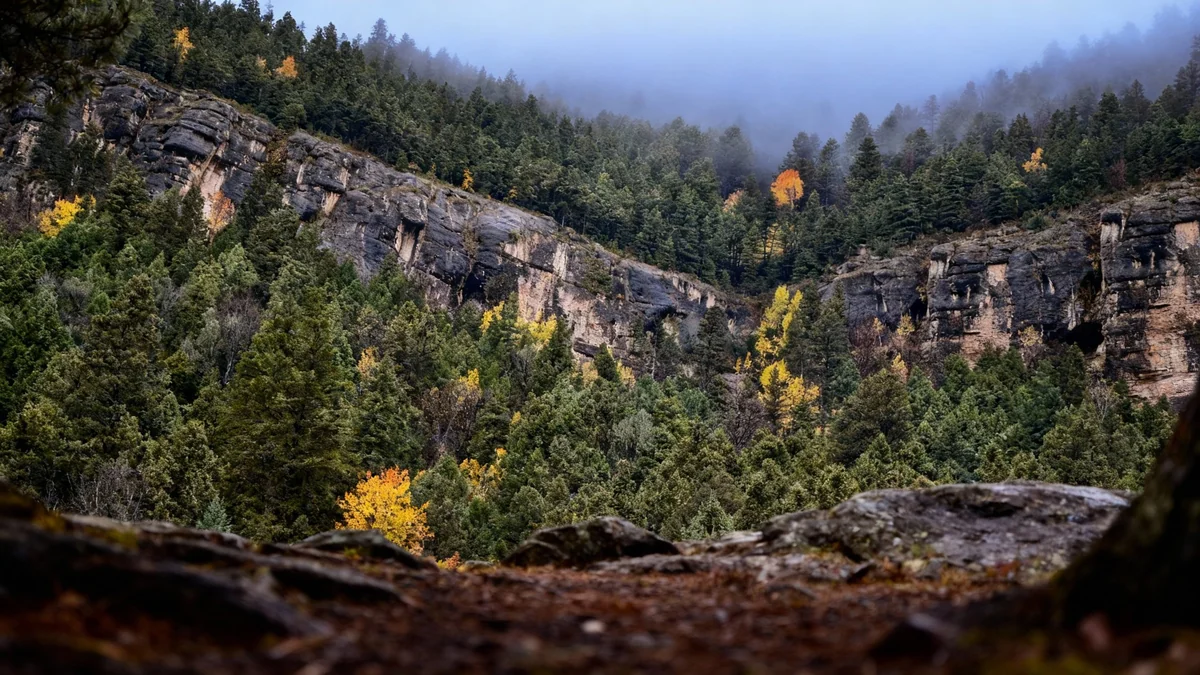A unique natural phenomenon, dubbed a 'leaf fall' of aspen trees, captivated a local resident in Sinks Canyon State Park this autumn. Instead of a typical waterfall, a cascading column of vibrant orange and gold aspen foliage descended through a drainage, offering a striking display rarely observed in the area.
Key Takeaways
- Lander resident Rose Vowles observed a rare 'leaf fall' of aspens in Sinks Canyon State Park on October 5.
- The phenomenon featured aspens descending through a drainage, showcasing vibrant orange and gold colors.
- Aspen groves are often interconnected through vast underground root systems, forming clonal colonies.
- Experts suggest the Sinks Canyon aspens could be a single grove or multiple connected groves.
- Altitude differences can cause variations in leaf color and appearance even within the same aspen system.
Unusual Autumn Display in Wyoming
Rose Vowles, a long-time resident of Lander, Wyoming, regularly visits Sinks Canyon State Park to witness the peak fall colors. Her routine includes checking on a specific aspen tree located on a rock ledge within the canyon. This year, her visit on October 5 brought an unexpected and spectacular sight.
Vowles discovered a column of aspen trees flowing downwards from the ridge into a drainage. The scene resembled a natural waterfall, but with leaves instead of water. The aspens at the top of the ridge displayed a vivid orange hue, while those lower in the drainage shimmered in classic gold.
“Instead of a waterfall, it was a leaf fall,” Vowles said. “I always stop at that one little spot to see ‘my tree,’ but this year all the other trees were visible and colorful. It's just so interesting.”
The rest of Sinks Canyon was covered in a layer of fog, making the 'leaf fall' even more prominent. For Vowles, these photos captured the highlight of an already beautiful autumn foliage season. She stated that she had never witnessed such a sight before.
Interesting Fact
Aspen trees are unique because a grove is not a collection of individual trees, but rather a single organism. All trees in a grove often grow from one shared root system, making them clones.
The Biology of Aspen Groves
Aspens are among North America's most distinctive trees. What appears to be many individual trees is often a single genetic entity. A grove of aspens is typically a collection of clones, all originating from one seed and connected by an extensive subterranean root system.
Shane Smith, a horticulturist and founder emeritus of the Cheyenne Botanic Gardens, emphasizes the scale of these organisms.
“Some people say it's the largest terrestrial organism on the planet,” Smith noted. “I can't guarantee that, but they’re pretty darn big.”
The most famous example is 'Pando,' a quaking aspen clone located in Utah’s Fishlake National Forest. Pando is recognized globally as the largest tree, with its root system spanning 106 acres. While Wyoming's aspen groves may not reach Pando's immense size, their multi-stem growth creates similarly impressive and delicate ecosystems.
Background Information
The health of one aspen tree can affect an entire grove due to their interconnected root systems. This sensitivity means that environmental impacts on one part of the grove can have widespread detrimental effects.
This interconnectedness is a key factor in conservation efforts. The U.S. Forest Service, the Wyoming State Forestry Division, and the Mule Deer Foundation are working to restore Aspen Alley in the Sierra Madre Mountains. Their work involves removing dead or dying trees to allow new, healthy shoots to emerge from the shared root system.
Smith also highlighted why aspens thrive in natural groves rather than as isolated landscape trees.
“It’s rare to see a single aspen,” Smith explained. “That partially explains why aspens are happier in groves than they are in yards. I tend not to recommend people grow aspen trees as a landscape option. They really don't like that sort of situation, and they aren’t nearly as healthy.”
Are the Aspens Connected?
Upon reviewing Vowles’s photographs of the Sinks Canyon 'leaf fall,' Shane Smith could not definitively determine if the display represented a single aspen grove or multiple distinct groves. There is a significant distance between the aspens on the upper ledge and those below in the drainage.
“They’re in the same drainage, so they might well be connected, but it’s hard to say for sure,” Smith commented.
Smith further elaborated that some aspen groves consist of different trees that have gradually grown together. These trees, while genetically distinct, can connect their root systems and function as a unified entity. This allows them to share nutrients, enhancing the overall health of the grove. If one tree faces a threat, it can even transmit signals to other connected trees.
Many tree species, including aspens, also benefit from mycorrhizal fungi. These fungi form symbiotic relationships with tree roots, improving nutrient uptake. Studies have shown that the presence of mycorrhizal fungi in native soil can increase the stem diameter, height, and number of root tips in aspen groves.
However, mycorrhizal fungi are not typically found in the Rocky Mountain region. Therefore, the aspens in Sinks Canyon likely do not benefit from these specific fungal advantages. Despite this, Smith believes something special might be occurring in the canyon.
“It's not a hard, fast rule that when you see a clump of aspens, they're always the same aspen,” Smith stated, suggesting the possibility of a unique connection.
Altitude and Appearance Variations
Smith suggested that the Sinks Canyon 'leaf fall' could indeed be two separate aspen groves that have merged through the drainage. Alternatively, it might be a single widespread system with shoots extending in an unusual pattern. Regardless of their exact connection, slight differences in altitude could explain variations in the appearance of the aspens.
Even within a single grove spread across different elevations, the trees can look distinct from top to bottom.
“The trees up top could be different from those down below,” Smith explained. “You might get a pooling of colder air the lower you go, which might give you a different look to the trees. A tree might be exposed to more wind in one place than another, with the same result. They might look like different trees even if the same tree.”
Despite these potential differences, Smith observed that the aspens in Vowles's photos appeared healthy. If they are not part of the same genetic grove, he suspects they are connected in some other way, perhaps through root grafting or communal resource sharing.
“The further the distance, the less likely they’re connected,” he added. “I don’t know what the distance is between those aspens, but if they’re healthy, it definitely increases the possibility.”
Rose Vowles continues to be amazed by the annual fall foliage in Sinks Canyon, particularly by the striking orange leaves of her favored aspen. This year's additional display of vibrant color descending the canyon walls was an especially memorable surprise.
“I've never noticed that there were other aspens falling down from the top one,” Vowles said. “It’s different from every other year I’ve stopped there. It was pretty cool.”




